
FinOps Software Explained: Benefits, Tools & Key Features
Table of Contents ToggleWhat FinOps Means in the Modern Cloud EnvironmentWhy...
Back
Back
Search for Keywords...
Blog

Table of Contents
Many organizations have begun to recognize SaaS Management as a driver of cost savings and risk mitigation. However, the obstacle to driving business outcomes lies in execution. The answer? SaaS Operations (SaaS Ops).
Today, your organization likely runs on hundreds of SaaS applications. While critical for daily operations, your stack is riddled with ballooning costs, overlapping tools, and significant security risks.
This is more than a minor inconvenience. It’s a multi-million dollar business problem that creates real, tangible risk for your organization. And it can wreak havoc on budgets and anticipated costs.
Add to this your organization’s political landscape, competing priorities, and no clear ownership of the technology strategy. That’s a confusing mess that’s difficult to untangle without a dedicated SaaS Operations professional.
SaaS Operations—or SaaS operations management—is responsible for building and running the day-to-day processes that turn SaaS Management from ad hoc tasks into a disciplined, repeatable, proactive practice. It serves as the bridge between IT, Procurement, Software Asset Management, and Security, ensuring your organization achieves the business outcomes of SaaS Management: inventory visibility, cost savings and avoidance, and compliance.
“Driving SaaS program value requires ownership and accountability. SaaS Operations delivers the structure and processes that make it possible.”
— Cory Wheeler, Co-founder and Chief Customer Officer, Zylo
Traditional IT Operations (IT Ops) focuses on the day-to-day management of an organization’s on-premises hardware, software, and network infrastructure.
Key responsibilities include:
While traditional IT Ops manages the entire IT environment, SaaS Ops specifically focuses on optimizing and governing cloud-based software applications. SaaS Ops differs in its scope, emphasizing financial optimization, license management, and vendor relationship management for SaaS applications, rather than the physical infrastructure.
Day to day, a SaaS Ops professional or team helps:
SaaS is now the second-largest operating expense for most organizations. Large enterprises manage 519-812 applications and waste $127.3M on unused licenses annually, creating mounting costs and unaddressed risk. With SaaS Ops in place, SaaS Management provides structure, accountability, and measurable value to the business.
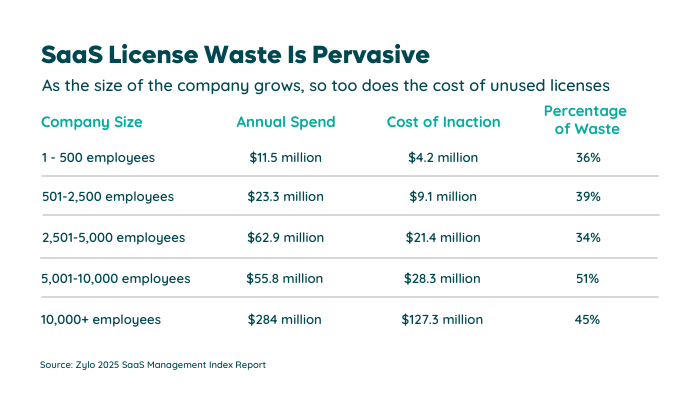
Most organizations understand the why of SaaS Management—cost savings, risk reduction, and better governance. What’s missing is the how. Teams see the opportunities but lack the time, expertise, and structure to act on them consistently.
A SaaS Ops professional fills that gap by providing that operational “how.” They connect processes, data, and stakeholders, and they operationalize the work so SaaS Management actually scales.
Without this role, SaaS Management stays fragmented, with different teams handling parts but no one driving the whole.
SaaS Ops encompasses the following components:
Enabling visibility across a decentralized SaaS Management team requires centralized data. SaaS Operations ensures that contracts, ownership, and utilization data are ingested into a continuously updated SaaS system of record, with real-time dashboards providing a single source of truth for:
Establishing clear ownership for each SaaS application is paramount. It ensures accountability and empowers individuals to make informed decisions regarding their assigned tools. SaaS Ops ensures:
When new applications enter your environment, it’s SaaS Ops’ responsibility to know about them and onboard them into your system of record. They set up automated alerts to identify new applications as they appear, while streamlined onboarding captures app owner and contract data from the start.
Applications selected for deprecation must be offboarded. SaaS Ops professionals monitor cancellations and complete offboarding to maintain clean data and surface license reclamation opportunities.
Shadow IT happens when you least expect it, so a dedicated SaaS Ops role is essential to identify and remediate it. They ensure all SaaS purchases are reviewed against policy, with out-of-compliance applications flagged and addressed through consolidation, offboarding, or formalization.
SaaS Operations is critical to proactively manage SaaS renewals. Leading SaaS Ops professionals adopt a 120/90/60/30-day workflow. They build the process with automated renewal alerts to ensure every renewal is prepared with license reclamation, utilization analysis, and fair pricing assessments.

License waste is a ripe opportunity for optimization. It’s imperative for SaaS Ops to identify inactive licenses and ensure they are reclaimed through ongoing workflows. This waste reduction should occur regularly and, most importantly, before renewal.
While all the previous components are essential to SaaS Ops, the most important one is giving your team clear visibility into value and financial accountability. SaaS Ops ensures that all savings and avoided costs are documented—which is made easy with tools like Zylo’s Savings Center.
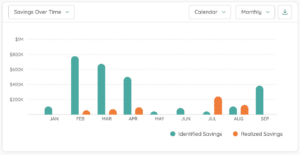
Without SaaS operations management, SaaS Management can remain fragmented:
Organizations often underestimate the number of applications in their inventory by nearly 2X, according to our data. Once they have that inventory, it’s challenging to keep the system of record up to date without a dedicated SaaS Ops role. This results in:
Our data shows that the average organization experiences 247 renewals annually—or one per business day. Without SaaS Ops, renewals catch Procurement unprepared, resulting in:
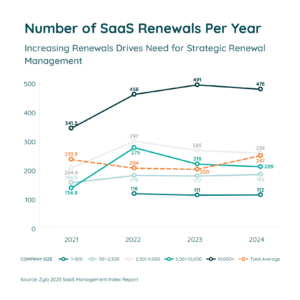
According to the 2025 SaaS Management Index, an average of 53% of licenses are not used in a given month. Each year, that leads to millions in wasted spending. A SaaS Operations professional ensures licenses are regularly monitored and rightsized to prevent overages, reduce waste, and minimize risk.
For organizations not actively managing SaaS, their portfolios could grow as much as 33% annually. This results in greater financial risk and broader security surface areas. Regular monitoring and strategic optimization can combat this—but is most effective when SaaS Ops is involved and orchestrating this initiative.
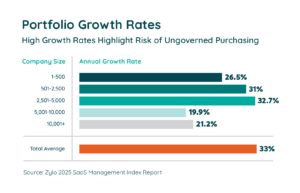
With 45% of applications considered shadow IT, according to our 2025 data, a dedicated role is required to monitor and eliminate it. Otherwise, it continues to evade detection, increasing spending and creating compliance gaps and security risks.
SaaS Management requires collaboration from IT, software asset management, procurement, and FinOps. But when everyone has a hand in it, there’s uncertainty on who actually owns the processes. The biggest risk here is that execution falters and the program stalls.
Manual SaaS Management with insufficient tools, reliant on disconnected spreadsheets and ad hoc communication, creates inefficiencies. This makes accurate inventory, usage tracking, and proactive renewal management nearly impossible, leading to:
A successful SaaS operations strategy ensures cost efficiency, risk reduction, and employee productivity. The four essential components are:
You can’t manage what you can’t see. The first step in SaaS operations is centralizing visibility of all your apps, spend, usage, and contracts. To do that:
Centralizing this data:
Automation reduces waste, enforces compliance, and prevents costly surprises. SaaS Ops should establish automations for:
When these processes are on autopilot, you can:
Focus resources on the applications with the greatest impact to maximize early wins. At Zylo, we recommend prioritizing your applications into tiers.
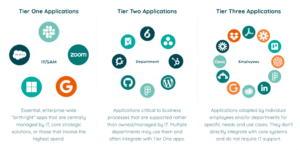
Not all applications deserve equal attention. Tiering enables IT and Procurement to address the biggest opportunities first—typically high-cost, high-use tools managed by IT.
By optimizing license allocation and contract terms for Tier 1 apps, teams generate immediate savings and risk reduction. Once these core apps are under control, organizations can expand efforts to departmental and long-tail tools, ensuring the program scales without overwhelming resources.
Governance establishes accountability and ensures SaaS growth is controlled. Include key guardrails, such as:
SaaS governance should strike a balance between innovation and control. Employees get the tools they need within a process that protects the business. Strong governance:
Unlike consultants that lack SaaS focus—or platforms that leave everything up to you—Zylo pairs SaaS-specific technology with embedded experts to deliver measurable business impact.
A dedicated SaaS Management Platform like Zylo is essential to implement your SaaS Operations strategy.
With Zylo’s SaaS Operations Services, our experts handle the day-to-day work for you, while you get the business outcomes.
Cut SaaS waste and build a repeatable savings pipeline.
Get a complete SaaS inventory and stay audit-ready.
Contact us to see how Zylo can serve as your SaaS Operations partner.
“[Our Services Manager] has been a key member, adding both experience and best practices to take us farther than we would have by ourselves. Six months in, Techstars is consistently saving more money and providing a better experience for our internal teams and financial leadership.”
— David Cano, Director IT and Security, Techstars
SaaS Operations focus on managing cloud-based applications—spend, licenses, renewals, and governance—while traditional IT Operations manage on-premises infrastructure and hardware. SaaS requires continuous discovery, cost control, and automation across decentralized purchasing, whereas IT Operations historically relied on centralized control of fixed assets.
SaaS Operations is a dedicated role or function but responsibility may be shared across IT, Procurement, finance, and security. Often, companies without a dedicated resource partner with a managed services provider like Zylo to fulfill the SaaS Ops role.
Most companies use a SaaS Management Platform (SMP) to centralize discovery, automate license workflows, track spend, and manage renewals. SMPs integrate with financial systems, SSO, and app APIs to provide real-time insights and enforce governance. Spreadsheets and legacy SAM tools are often inadequate for SaaS.
IT reduces SaaS costs by reclaiming unused licenses, consolidating redundant apps, and ensuring contracts align with actual usage. Automating workflows prevents idle licenses and missed renewals. Continuous visibility also eliminates shadow IT and identifies opportunities for contract optimization, turning cost avoidance into measurable savings.
SaaS Operations improve compliance by delivering visibility into every application in use. With that inventory in place, teams can enforce compliance by ensuring every app has an owner, contract, and access controls. Governance policies—like SSO requirements, risk scoring, and renewal reviews—reduce shadow IT and audit gaps. This visibility creates a defensible record of compliance, strengthens security posture, and improves accountability across business units.
A SaaS Operations Manager oversees the entire SaaS lifecycle. They maintain visibility into the portfolio, enforce governance guardrails, optimize licensing, and coordinate renewals. Their role spans IT, procurement, and finance, ensuring SaaS investments deliver value while minimizing risk, waste, and administrative complexity across the business.
Common mistakes include relying on spreadsheets, treating SaaS as traditional IT, ignoring shadow IT, and failing to secure executive buy-in. Many organizations also miss savings by not automating license reclamation or renewal tracking. Without governance, portfolios sprawl, leading to wasted spend and compliance risks.
The first step is centralizing visibility with a SaaS system of record. This establishes a comprehensive inventory of all applications, owners, contracts, spend, and usage. Without this foundation, it’s impossible to optimize licenses, manage renewals effectively, or enforce governance. Visibility enables every other SaaS Operations initiative.

Table of Contents ToggleWhat FinOps Means in the Modern Cloud EnvironmentWhy...

Table of Contents ToggleWhat Is SaaS Operations?SaaS Ops vs Traditional IT...

Table of Contents ToggleWhat Is SaaS Operations?SaaS Ops vs Traditional IT...

Table of Contents ToggleKey Themes That Shaped SaaS Management in 20251....
| Cookie | Duration | Description |
|---|---|---|
| cookielawinfo-checkbox-analytics | 11 months | This cookie is set by GDPR Cookie Consent plugin. The cookie is used to store the user consent for the cookies in the category "Analytics". |
| cookielawinfo-checkbox-functional | 11 months | The cookie is set by GDPR cookie consent to record the user consent for the cookies in the category "Functional". |
| cookielawinfo-checkbox-necessary | 11 months | This cookie is set by GDPR Cookie Consent plugin. The cookies is used to store the user consent for the cookies in the category "Necessary". |
| cookielawinfo-checkbox-others | 11 months | This cookie is set by GDPR Cookie Consent plugin. The cookie is used to store the user consent for the cookies in the category "Other. |
| cookielawinfo-checkbox-performance | 11 months | This cookie is set by GDPR Cookie Consent plugin. The cookie is used to store the user consent for the cookies in the category "Performance". |
| viewed_cookie_policy | 11 months | The cookie is set by the GDPR Cookie Consent plugin and is used to store whether or not user has consented to the use of cookies. It does not store any personal data. |
